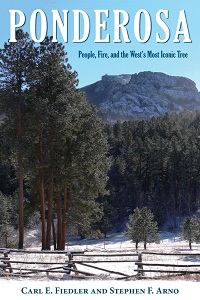
For many years, I would travel to eastern Washington for Thanksgiving. On these trips, I was always struck by the seemingly sudden appearance of ponderosa pine trees
(Pinus ponderosa), when crossing the Spokane County line, after many miles of agricultural fields or grasslands. These stately trees created a park-like setting as they were well-spaced, with little undergrowth. It seemed idyllic.
Ponderosa: People, Fire, and the West’s Most Iconic Tree by Carl E. Fiedler and Stephen F. Arno helped me to understand this ecosystem better. These ponderosa-dominated forests are found in places of “climatic moderation,” typically sharing “boundaries with drier grasslands below and moister, mixed conifer forests above.”
Several of these forests can be found throughout the western United States. In addition to Spokane, other cities in Oregon, Nevada, northern Arizona, and even as far east as South Dakota have similar settings. Prior to Euro-American settlements, these were desirable places for indigenous peoples and for the animal life that often sustained them.
The recent story of the ponderosa pine is closely linked to the timber industry, starting about the time of the California gold rush in the mid-1800s, and ongoing to the present. The authors chronicle in great detail the evolving practices and debates about managing forest lands, especially fires. Should all fires be extinguished at all costs? Should fire be used as a tool? What are the best practices to prevent catastrophic damage to human settlements? These questions have been long debated, and this book’s history is useful in understanding the elements of this debate.
The end of the book includes descriptions of several prominent ponderosa forests listed by state. In Washington, this includes the White Pass Scenic Byway and, surprisingly, the area around Fort Lewis near Tacoma. Ponderosas generally don’t compete well with other conifers in the more humid, western side of the Cascades, but this may be a remnant from a warmer and drier time.
This book was published in 2015. The same authors teamed up for a book in 2020 about another iconic tree:
Douglas Fir: The Story of the West’s Most Remarkable Tree. I recommend both for a better understanding of the history and ecology of the forest lands in the western North America.